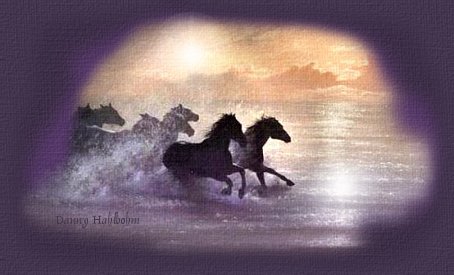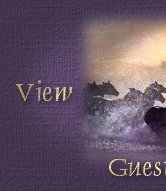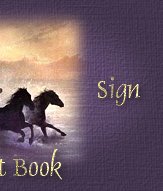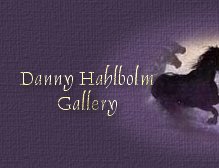

If you are lucky you will see them as they fly across the ground,
bold and beautiful with the wind blowing through their thick, long manes.
Each hoof gently but surely finds its place in the rocky terrain,
seemingly unaffected by the mist that covers the hillside. A river does
not stop them, and as they charge on the water splashes and falls like
rainbowdrops in the evening sun. The colours are fascinating, there is
no end to their variation. Black, bay, pintos run side by side. Strangers
wrongfully refer to them as ponies because of their size, but if you have
seen the strenght and grace of these horses you cannot doubt that
they deserve to be called just that, horses. They are different from
other horses. They have even been blessed with two more gaites, tölt
and flying pace, which comes as natural as breathing to the divine horses,
the Icelandic Horses.

The Icelandic horses were brought to Iceland by the very first settlers and
have ever since played a large role in the Icelandic society. In the 10th
century, importation of horses was banned, and still is. This bann was created in
order to stop illnesses and epidemics, but also due to the local farmers' economic
interests. The horses were part of every day life, and the famous Icelandic sagas
contain many descriptions of these brave animals.

Nowadays its popularity constantly increases, and they are best know for
their gaits, tölt and flying pace. Gentle and strong, they move with a grace and
certainty which has been a necesity for centuries as they were bred in a harsh
environment. Many owners feel still feel that a true Icelandic horse is one brought
up roaming freely on Iceland. They have their own will and spirit which should
never be broken by man. It is far too valuable. An Icelandic horse should always
be treated as a friend and companion, not just as an obedient subject.

Toelt is perhaps what the Icelandic horse is best known for, but it has not always
been appreciated outside of Iceland. It is the most comfortable of the Icelandic
horse´s gaits. Toelt is a four-beat gait similar to walk. The horse always has a hoof
on the ground, which makes its movements very smooth. It is not unusual to
show its softness at horseshows by riding holding a full glass of champagne without
spilling a drop. Toelt can be just as fast as canter, so it is quite a different feeling.
When the Icelandic horse was first introduced in Sweden breeders attempted to
eliminate tölt, but luckily tölt is now highly appreciated. Pace, or flying pace as it is
sometimes called, is a lateral two-beat movement, where balance is of the outmost
importance. Not all Icelandic horses know how to pace, and a saying goes that
pace is as valuable as gold if the rider know how to handle it.




